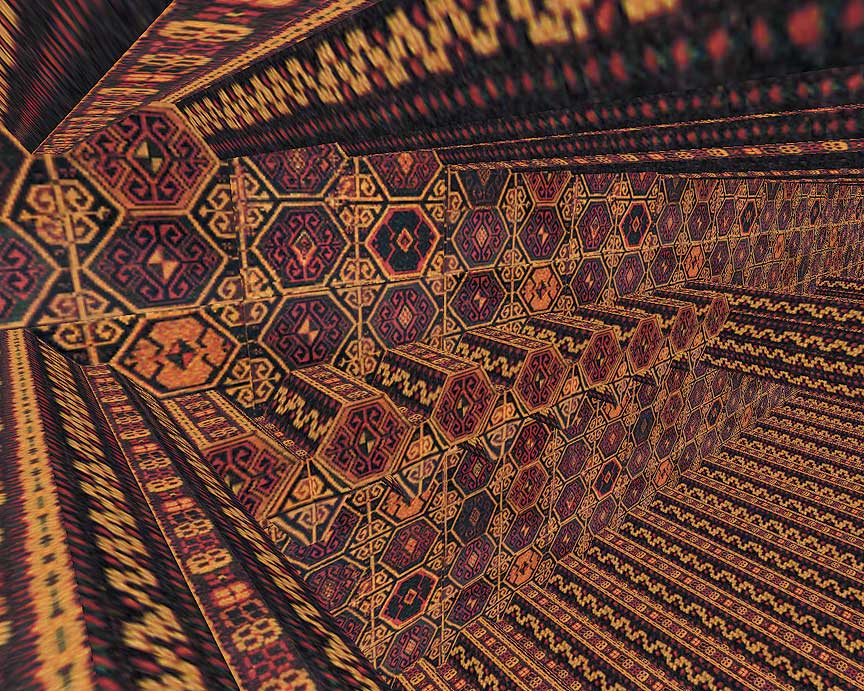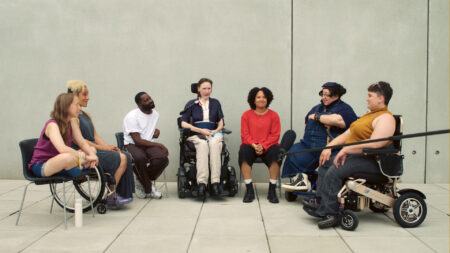Interview
“Knowmad”

Mel Chin. KNOWMAD, digital still, 1999. Collaboration with the KNOWMAD Confederacy. The images and motifs used in KNOWMAD were taken directly from weavings by nomadic peoples of Iran, the Caucuses, Afghanistan, Azerbaijan, Central Asia, and Anatolia (in present-day Turkey). Courtesy of the KNOWMAD Confederacy.
Mel Chin discusses his 1999 interactive video installation KNOWMAD.
ART21: How did Knowmad evolve?
CHIN: I was interested in the maps that are not written down but created in the mind. And where do they occur? In contemporary culture, they occur with eleven-year-olds, ten-year-olds, playing video games and winning or getting the prizes or whatever they do, slashing or slaying the beast. And they memorize their path because that’s the one way—it’s the start of memory—and that intrigued me. How can we create this kind of mapping? I’ve been interested in arcade games and in all these things, not necessarily as a player, and not necessarily as one who participates in that, but as it has a profound effect on culture. How do ideas survive in culture? Not necessarily my ideas or anybody’s ideas, but how do ideas stay around long enough to have a conversation? From a conceptual standpoint, I’m interested in that. And knowing that video games probably equal or better Hollywood in their volume of intake of money shows you how much influence it has in the world. And then where is the art? Where is the cultural aspect involved with it?
ART21: The map in the mind and a kid memorizing the path—could you talk about that a little more?
CHIN: Other people who, I feel, probably don’t have maps that are written down are nomads. And that’s the third factor—artists, the world of art—are also people who roam in the mind. You travel and come upon things and places. In some places, I feel like being an artist is about this idea of survival, let’s say, or this concept about the survival of ideas to what you do—your own ideas, or others, or things that you have stumbled upon. In terms of nomadic culture, I feel it’s not so romantic as we would have it—a Jack Kerouac, Dharma Bum attitude about it—that has been infused, of course. And Kerouac’s a little more complicated than that, but there is this idea of American culture, of being a nomad, this freewheeling attitude. And real nomadic culture, I feel—its more about survival, visible survival. This idea of these mappings of the mind—I feel that there are parallels. Think about the artifacts of a culture, like travel culture, where creativity is kind of woven into the fabric. And what’s roaming around are these beautiful objects that portrayed it for capital, or whatever, to survive. So, there are meaningful things that were created in travel culture that are being lost in those parts of the world. And with it, we lost this method of transmission of ideas.
ART21: What kinds of ideas get transmitted in tribal rugs? Some of the patterns are maps to meditation; they’re used for prayer purposes.
CHIN: Well, certain prayer rugs are very specific; we know what they are for. But tribal weavings don’t have that. They’re more secular and were made for—[from] my knowledge of them—they were made for trading and giving, for warmth, and also for comfort. So, their value is there within the tent or within what you’re living in. But anyway, I think that what you see from place to place is that there are repeated patterns, but they are different. And this is a way of people being able to express themselves in a very sincere and difficult way. It’s not easy to create those things, knot by knot.

Mel Chin. KNOWMAD, 1999. Collaboration with the KNOWMAD Confederacy. Interactive video installation with Playstation, vintage carpets and fabric tent; dimensions variable. Courtesy of Frederieke Taylor Gallery, New York.
ART21: Isn’t there another element there—that nomadic people don’t exist on a map?
CHIN: Well, yes, because of the political issues. The Kurds don’t have a nation. There’s no Kurdistan anymore, and they’re not recognized. In some parts of Turkey, they can’t even speak Kurdish. And when the Shah of Iran came to power, one of the projects was the destruction of tribal culture, of its political impact, so there was active engagement in the removal of these associations. There is a constant remapping in the real world. But I guess the whole project itself is about creating the possibilities for the player or the person in the game to travel from the cathode ray version to the wool version, and back and forth, and see associations that are not always in front of you. So, if you never had any knowledge of either one, you would walk away with this possibility of knowing more about both, you know?
ART21: And the sense of knowing would be a visual knowing?
CHIN: It’s visual, and I feel that this is where it can begin. This visual knowing begins with a recognition—that first, you recognize that this game is created, these fantastic worlds that were created by the Knowmad Confederacy, came from a source that was equally fascinating. So, this project is sort of a homage to both: to the gaming culture (what it can offer in association with art or conceptual art) and what tribal culture has offered (not just these objects and artifacts that come from real people). If you look into them, beyond their pattern and beyond their beauty, they came from women who have woven these rugs for thousands of years. That may no longer exist.
ART21: Is there a goal?
CHIN: I don’t think the goal of art is just this travel of the mind, the travel of the passion to discover more. I always describe art as a catalytic structure that actually creates the possibility for languages to be formed or the place where language is to be formed. And I keep saying that because I want to be clear that art can have an effect, a movement. And this movement from place to place creates options and perhaps the only vestiges of freedom and thinking that we have. Because I feel that—and I can only speak for myself—but I think we’re full of (or I’m full of) delusions about what things are, and I’m not so sure. The job description is to create the paths or the methods to enlarge on that and to create options to the activities that you do. So, there is some freethinking. The question is: can you be responsible in ignorance? I think you can play the game and not have the direct associations of “Oh, now I’m going to find out about travel culture,” but play the game and say, “Wow, video games can be more than the dungeons and slashing projects that I’ve seen before, [in] games before.” They can be more about a visual reward, and that’s okay, too. So, I think it’s about creating flexible space, conceptually and personally.



